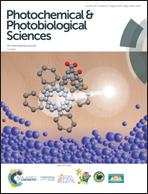A dormant BODIPY-acrolein singlet oxygen photosensitizer intracellularly activated upon adduct formation with cysteine residues†
Abstract
Here we report the activatable photosensitizer BromoAcroB, a brominated BODIPY dye incorporating a reactive acrolein warhead. The acrolein moiety serves as an intramolecular switch, deactivating the BODIPY dye in its singlet and triplet excited states via internal conversion. Thiolate addition to this moiety disables the intramolecular quenching mechanism restoring the photosensitizing properties of the parent dye, characterized by a quantum yield of singlet oxygen photosensitization of 0.69 ± 0.02. In cell cultures, and upon thiol adduct formation, BromoAcroB induced light-dependent cell death in MRC-5 and HeLa cell lines. Using fluorescence microscopy and upon measuring the low yet non-negligible emission of the activated compound, we show that the phototoxicity of the dormant photosensitizer correlated with the quantity of BromoAcroB adducts generated. BromoAcroB thus serves as a dormant photosensitizer sensitive to intracellular electrophile response. Our results highlight the effective control of a triplet state process by modulation of an unsaturated moiety on the BODIPY scaffold and underscore the mechanistic opportunities arising for controlled singlet oxygen production in cells specifically sensitive to electrophile stress.



 Please wait while we load your content...
Please wait while we load your content...